- Home
- Academics
- Arts & Sciences
- History & Geography
- About Our Department
- Art History
- Art History Speaker Series
Art History Speaker Series
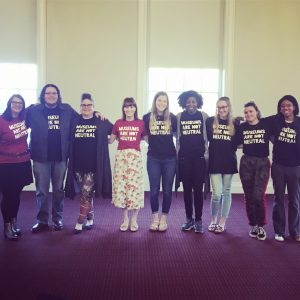
Students and faculty with La Tanya Autry.
Since 2003, Elon’s art history program has sponsored a speaker series that has brought art historians to campus. From world-renowned scholars to early career researchers, our guests have shared the breadth of what is possible in art historical research with our community. With several talks scheduled each year, the series allows students to interact with significant and emerging scholars in the field. The series also provides an opportunity to showcase our faculty experts and our connections with programs across the university. Past speakers include La Tanya Autry (pictured at left), Maggie Williams, Timon Screech, Norman Bryson, Terry Smith, Carol Duncan, Barbara Abou-el-Haj, Frank K. Lord, Esq., Rebecca Brown, Carol Mattusch, John Neff, Gennifer Weisenfeld, Rebecca Martin Nagy, Dorothy Verkerk, Judith Rodenbeck, Rachael Ziady DeLue, David M. Lubin, Mary D. Sheriff, James Elkins, and Jaroslav Folda. Students are encouraged to recommend scholars they wish to meet.
Fall 2024
Thursday, November 14, 6:00-7:30 pm
LaRose Digital Theatre (KOBC 101)
Dr. Sora Han, Professor of Criminology, Law & Society, Comparative Literature, and the School of Law at the University of California, Irvine
When Artists Take Legal Matter* into Their Own Hands
*Not a typo! Come to the talk.
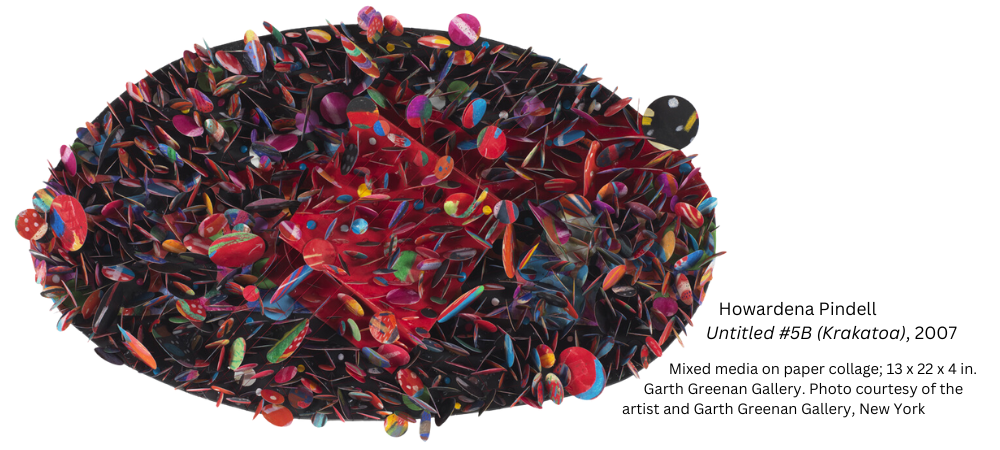 How does art engage with the formal limits of legal interpretation? This talk will survey a set of contemporary artists who use the materials of legal practice in their work, including Charles Gaines, Howardeena Pindell, Tania Bruguera, Maria Gaspar, Samuel Levi, and others. These artists approach law as matter – words from judicial opinions, office supplies from administrative agencies, horses from policing units, bricks and rebar from criminal justice buildings, casebooks from law schools – to force the routinized violence of legal formalism into more expansive social performative spaces. Their works are concerned less with how courts and lawyers might answer the question, “is it legal?” and more with how everyday people might answer the question, “what is law?”
How does art engage with the formal limits of legal interpretation? This talk will survey a set of contemporary artists who use the materials of legal practice in their work, including Charles Gaines, Howardeena Pindell, Tania Bruguera, Maria Gaspar, Samuel Levi, and others. These artists approach law as matter – words from judicial opinions, office supplies from administrative agencies, horses from policing units, bricks and rebar from criminal justice buildings, casebooks from law schools – to force the routinized violence of legal formalism into more expansive social performative spaces. Their works are concerned less with how courts and lawyers might answer the question, “is it legal?” and more with how everyday people might answer the question, “what is law?”
Sora Han is Professor of Criminology, Law & Society, Comparative Literature, and the School of Law at the University of California, Irvine and was recently a Fellow at the Clark Art Institute. She also worked as a legal advocate for women prisoners in California, focusing on medical neglect and compassionate release cases. Her first book, Letters of the Law (Stanford University Press 2016), extends the theoretical insights of critical race theory to produce new readings of American law’s landmark decisions on race and civil rights. She is a co-author of the law casebook, Comparative Equality and Anti-Discrimination Law, Third Edition (Edward Elgar Publishing 2020). Her newest book, Mu, 49 Marks of Abolition, published by Duke University Press (March 2024), is an experimental text on the poetics of law in the wake of racial slavery. Recent publications on these new lines of research include “Slavery as Contract,” in Law and Literature (2016), “Poetics of Mu” in Textual Practice (2018), and “Res Nulla Loquitur” in Women & Performance (2024), with its multimedia companion, Res Nulla Loquitur in b2o (2022). She also published her first book of poetry, to regard a wave, with Selva Oscura Press (2024).
Fall 2023
Thursday, October 26, 6:00-7:30 pm
LaRose Student Commons Room 200
Identity and Experience: A Roundtable Exploration of Imagined Spaces
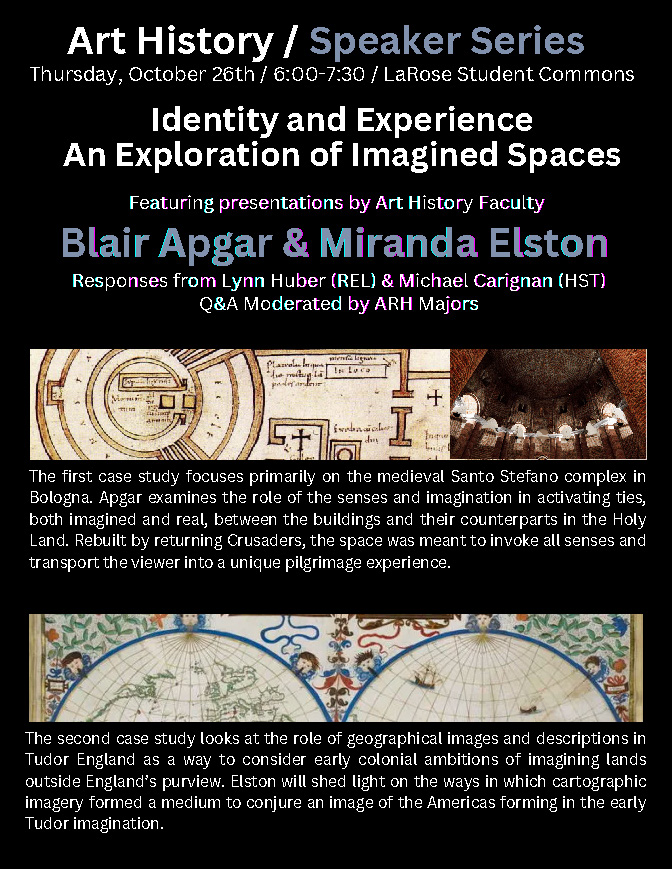 The roundtable will center the expertise of Dr. Blair Apgar and Dr. Miranda Elston followed by short responses from Dr. Lynn Huber and Dr. Michael Carignan. The session will explore how space is imagined and mapped, and it reflects the identities of the designers and users via two fifteen-minute papers presented in dialogue, each offering a different perspective on the ways in which material aspects of spatial environments can be translated into meaning.
The roundtable will center the expertise of Dr. Blair Apgar and Dr. Miranda Elston followed by short responses from Dr. Lynn Huber and Dr. Michael Carignan. The session will explore how space is imagined and mapped, and it reflects the identities of the designers and users via two fifteen-minute papers presented in dialogue, each offering a different perspective on the ways in which material aspects of spatial environments can be translated into meaning.
The first case study, presented by Blair Apgar, is focused primarily on the medieval Santo Stefano complex in Bologna. Apgar examines the role of the senses and imagination in activating ties, both imagined and real, between the buildings and their counterparts in the Holy Land. Rebuilt by returning Crusaders, the space was meant to invoke all senses and transport the viewer into a unique pilgrimage experience.
The second case study, presented by Miranda Elston, looks at the role of geographical images and descriptions in Tudor England as a way to consider early colonial ambitions of imagining lands outside England’s purview. This paper will shed light on the ways in which cartographic imagery formed a medium to conjure an image of the Americas forming in the early Tudor imagination.
These two papers will interrogate the varying cultural experiences of space through an art historical lens. Although drawing on different periods and regions, both papers will reflect on the role of identity, both actual and imagined, as a strong motivating factor in the construction and use of these spaces.
Spring 2023
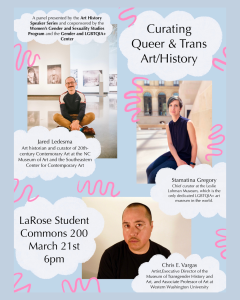
Tuesday, March 21, 6:00 pm
LaRose Student Commons Room 200
Curating Queer and Trans Art/History
This panel brings together Chris E. Vargas, Exec. Dir. of MOTHA, Associate Professor of Art, Western Washington University, Stamatina Gregory (Chief Curator/Dir. Of Exhibitions and Collections, Leslie Lohman Museum of Art and Jared Ledesma (Curator of 20th and 21st-century Art, NC Museum of Art and SECCA).
Fall 2022
Wednesday, October 19, 6:00 pm / LaRose Digital Theatre (Love School of Business)
Dr. Elizabeth C. Teviotdale, CMRS Center for Early Global Studies, UCLA
Time in the Stammheim Missal
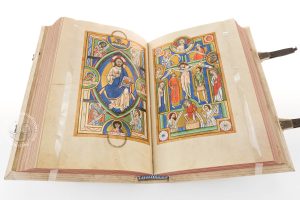
The Stammheim Missal (Los Angeles, J. Paul Getty Museum, MS 64) is a major monument of twelfth-century European art. Created at and for the Benedictine monastery of St. Michael’s at Hildesheim in northern Germany, it boasts spectacular illumination, including miniatures of great theological complexity, fully painted text pages, historiated initials, painted architectural frames, and a liturgical calendar with painted decoration. This lecture explores the contribution of the representation of time in the missal’s calendar to the book’s program of illumination. The specificity of the calculation of the equinoctial hours in each month and their graphic representation in the calendar contribute forcefully to the message of the program of the full-page miniatures: that for medieval Christians, the promise of salvation was inherent in Creation. (Left: Opening from the Stammheim Missal. Photo by Facsimile Finder.)
Spring 2022
Wednesday, March 30
Dr. Caitlin Glosser
Making Absences Present: Visualizing Records from the Musée Africain de Lyon
Glosser graduated from Elon in 2012 with majors in Art History and French and a minor in Italian. At Elon, Glosser was an Elon College Fellow, mentored by the fantastic Dr. Kirstin Ringelberg For her Fellows project she conducted research and wrote an article-length essay on “Medium-Specificity in Whistler & Debussy”.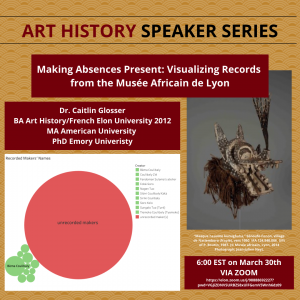
After leaving Elon, Glosser went on to earn an MA in Art History from American University in 2014 working with Juliet Bellows on a thesis titled: “Reimagining the Gesamtkunstwerk: Guillaume Apollinaire’s A Quelle Heure Partira-t-il unTrain Pour Paris?” 2014. In 2015 Glosser returned to Elon for Art History’s Tenth-Anniversary Symposium (Between, Among, and Across: Transhistories of the Visual) presenting a paper based on her MA work titled “Painting Modern Life: Guillaume Apollinaire’s Et moi aussi je suis peintre” as part of our alumni panel. Glosser then went on to Emory University where she earned a PhD. in December 2020. Glosser’s dissertation research focused on questions of intermediality, collaboration, gender, race, power, and the construction of knowledge. In her dissertation, “Sonia Delaunay’s Cross-Media Abstraction,” she challenges the way modern art history privileges certain artistic practices and identities by claiming the significance of Delaunay’s cross-media, collaborative work in the development of early 20th-century abstraction.
In the spirit of collaboration, Caitlin has also spent three years at Emory working with a team on the digital-born project Mapping Senufo, visualizing the knowledge infrastructure around Senufo-labelled objects from Côte d’Ivoire. A tableau summary of Caitlin’s contributions to this work appears in Susan Gagliardi’s “Mapping Senufo: Mapping as a Method to Transcend Colonial Assumptions,” in The Routledge Companion to Digital Humanities and Art History edited by Kathryn Brown (2020) and Glosser has presented “Mapping Senufo: Visualizing Silences in Museum Records” at the 2021 ARTS COUNCIL OF THE AFRICAN STUDIES ASSOCIATION in a panel presented as part of a panel on how computational analysis changes the way scholars approach historical evidence.
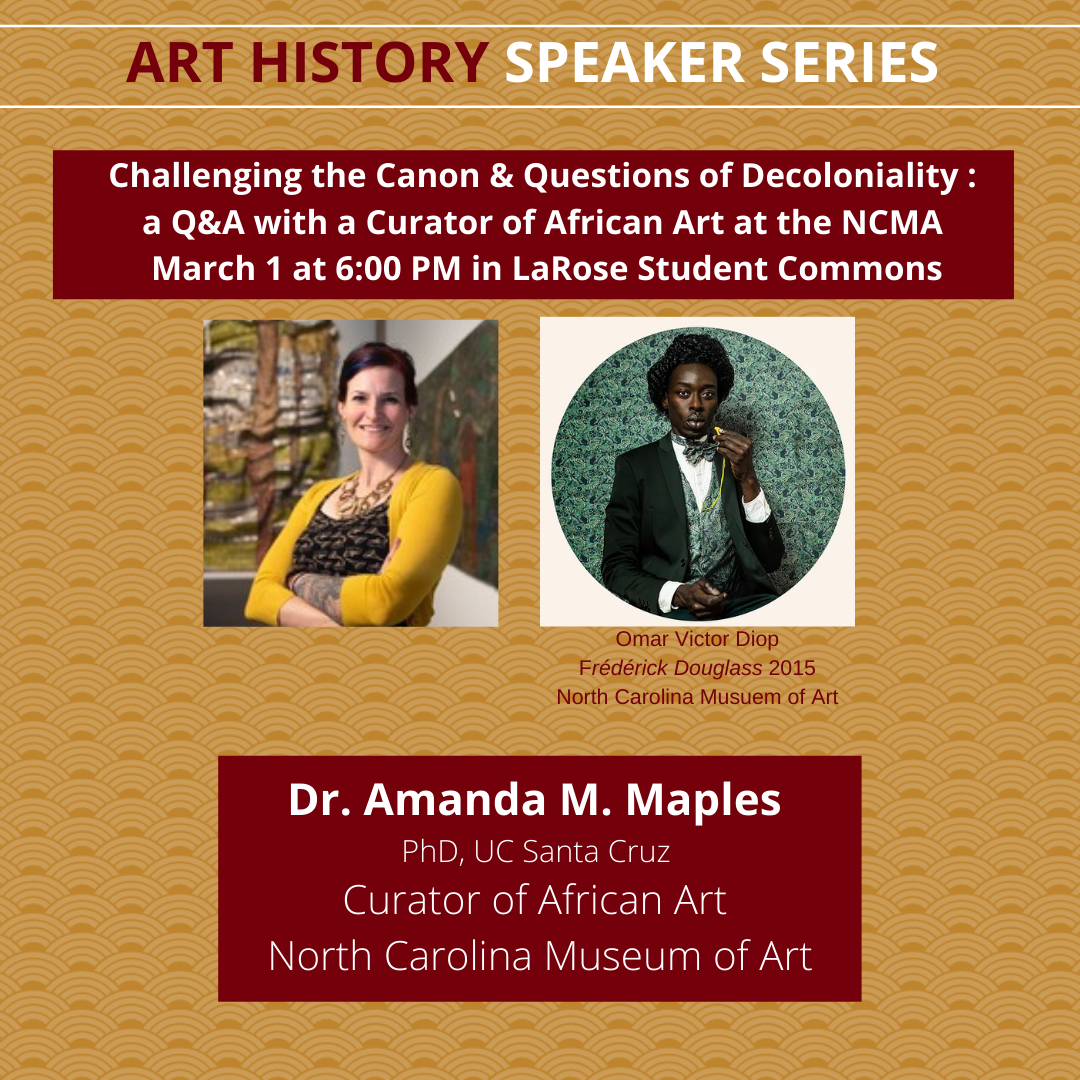
Tuesday, March 1
LaRose Student Commons
Amanda M. Maples,
Challenging the Canon & Questions of Decoloniality: A Q&A with the African Art Curator at the NCMA
Maples is the first permanent curator of African Art at the NCMA and has expanded the museum’s collection in important and exciting ways. She is currently engaged in the reinstallation of the African Galleries which should open later this year. Dr. Maples has also curated shows at the National Museum of African Art and has worked with Digital Benin.
Fall 2021
Tuesday, November 9
Dr. Chris Motz
Assistant Professor, Elon University (2021-2022)
Building Roman Industries: Exploring Ancient Communities of Knowledge Through History and Archaeology
ZOOM
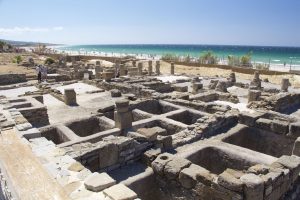
At the end of the 1st century BCE, a group of workers built a fish-salting factory in central Italy using virtually identical techniques as the team that installed a set of salting vats in southwest Spain a few generations earlier. How did this happen? The builders certainly never met, so the resemblance between their constructions is remarkable. But even more striking is how common this phenomenon was among the countless workshops, drains, cisterns, and other ordinary, mundane structures found throughout the Roman world. The basic explanation for these similarities is simple: the knowledge that underpinned their design and construction spread from person to person and place to place. The details of this process, however, are far from simple. This presentation will explore how the movement of knowledge among builders, shopkeepers, and laborers shaped the construction of ancient workshops and factories. Drawing on a survey of over 400 industrial buildings from across Rome’s empire as well as recent excavations at Pompeii, this presentation will bring together archaeology, art, and texts to reconstruct these ancient networks of knowledge and reveal some inner workings of the intellectual infrastructure of the Roman world.
Spring 2020
Tuesday, March 10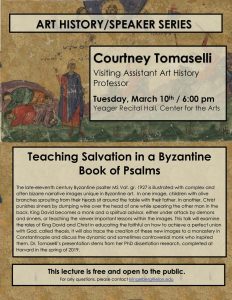
Dr. Courtney Tomaselli, “Teaching Salvation in a Byzantine Book of Psalms”.
Yeager Recital Hall, 6:00
The late-eleventh century Byzantine psalter MS Vat. gr. 1927 is illustrated with complex and often bizarre narrative images unique in Byzantine art. In one image, children with olive branches sprouting from their heads sit around the table with their father. In another, Christ punishes sinners by dumping wine over the head of one while spearing the other man in the back. King David becomes a monk and a spiritual advisor, either under attack by demons and sinners or teaching the viewer important lessons within the images. This talk will examine the roles of King David and Christ in educating the faithful on how to achieve a perfect union with God, called theosis. It will also trace the creation of these new images to a monastery in Constantinople and discuss the dynamic and sometimes controversial monk who inspired them. Dr. Tomaselli’s presentation stems from her Ph.D. dissertation research, completed at Harvard in the spring of 2019.
Fall 2019

Katharine Rhoades, 1915, photograph by Alfred Stieglitz
Tuesday, September 24th
Jessica Murphy, “Katharine Nash Rhoades, Muse, Artist, & Modern Woman”.
Yeager Recital Hall, 6:00
Artist and poet Katharine Nash Rhoades (1885-1965) was active within American modernist circles in the 1910s: regularly attending gatherings at Alfred Stieglitz’s pioneering gallery at 291 Fifth Avenue, exhibiting her paintings at the legendary Armory Show of 1913, traveling and making art with fellow expatriates in France. In most studies of this era, however, she has been mentioned only as a model (and occasionally a romantic interest) for male artists of this era, including Stieglitz, Arthur Carles, and Edward Steichen. This presentation by Jessica Murphy of the Brooklyn Museum of Art will take a closer look at Rhoades’s own paintings and writing, her artistic practice, and her collaborations with other women, including her close friend Marion Beckett. In her various roles at 291 and beyond, Rhoades stands as a unique case study of a woman who negotiated the boundaries of feminine identity and modernism through her alliances and her art.
Spring 2019

Wednesday, February 27
Matthew Lincoln, “Predicting the Past: What Data Science Gets Wrong About The History Of Art, And Why That Makes It Useful”
LaRose Digital Theatre, Koury Business Center, 6:00
What makes a painting “British?” What makes an artist an “Old Master?” We can define these categories as a function of historical factors like birthplace or time, or of style, technique or subject matter. But we also know full well that these are highly constructed categories; as much as anything else, “Britishness” (and other categories) can be imparted by shared rhetorical conventions for describing an artwork or an artist, and that definition can change with time, or diverge depending on who is doing the describing. As part of a larger project in the history of the art market, Dr. Lincoln will examine rhetoric and word choice in a large corpus of public sales catalogs, comparing auctioneers’ language to the kinds of categories like nationality or period that today structure so much of our art historical work. What simulation and statistical modeling gets right when trying to predict these categories, as well as what it gets wrong, give crucial insights when we talk about art and shows that studying the art market can be about much more than prices.
Matthew Lincoln is the Digital Humanities Developer at dSHARP, the digital scholarship center at Carnegie Mellon University, where he focuses on computational and data-driven approach to the study of history and culture. His current book project with Getty Publications, co-authored with Dr. Sandra van Ginhoven, uses data-driven modeling, network analysis, and textual analysis to mine the Getty Provenance Index Databases for insights into the history of collecting and the art market. He earned his Ph.D. in Art History at the University of Maryland, College Park, and has held positions at the Getty Research Institute and the National Gallery of Art. He is an editorial board member of The Programming Historian.
Fall 2018
 Tuesday, October 2
Tuesday, October 2
Maggie M. Williams, “Art History and Public Medievalism”
Yeager Recital Hall, 6:30 p.m.
The history of art—particularly medieval art—might seem irrelevant to our daily lives. But images, screens, and visual culture play an enormous role in twenty-first-century culture, and we often encounter medieval references in extremely politicized contexts. What are an art historian’s responsibilities in this arena, and how can they contribute to public scholarship beyond the university? In this presentation, Maggie M. Williams, a founding member of the Material Collective, will discuss how and why she has worked to combine activism and public outreach with academic scholarship. Her talk will address the relevance of art history and the study of the past to life and politics in the contemporary world.
Spring 2018
 Tuesday, April 10
Tuesday, April 10
La Tanya Autry, “Reform or Revolution: Centering Social Justice in Museums”
Clohan Theater, Inman Admissions Building, 6 p.m.
La Tanya S. Autry, Curator of Art and Civil Rights at the Mississippi Museum of Art and Tougaloo College, discusses how we can decolonize our museums and create socially just centers. Her critique calls for systemic change grounded in intersectionality and equity. In challenging the status quo, she questions the very definition of museums. While completing her Ph.D. in art history at the University of Delaware and working as a curatorial fellow in photography at the Yale University Art Gallery, Autry co-curated, with Gabriella Svenningsen Omonte, The Art of Black Dissent, a traveling pop-up exhibition and dialogue-based program. She also began an internationally crowdsourced list of social justice and museum resources in the wake of #museumsrespondtoferguson and collaborated with Mike Murawski on “Museums Are Not Neutral”.
Fall 2017
 Tuesday, September 19
Tuesday, September 19
Claudia Brittenham, “Unseen Art in Ancient Mesoamerica”
Yeager Recital Hall, 6 p.m.
Claudia Brittenham’s research centers on the art of ancient Mexico, Guatemala and Honduras, with a special interest in issues of art and identity, intercultural interaction, the materiality of art and the politics of style. Her current research project examines problems of visibility and the status of images in Mesoamerica. Unlike objects made to be displayed in modern art museums, many visually elaborated Mesoamerican objects would have been extraordinarily difficult to see in their original contexts. By exploring these conditions of visibility, Brittenham suggests that art could operate beyond the realm of the visual, and explore the ways in which concealed images and esoteric knowledge might be used to maintain power and social difference.
Spring 2017
 Thursday, February 23
Thursday, February 23
The Art History Speaker Series presents a Maya Studies Panel, “From Communities to States, Perspectives in Maya Art, Archaeology, and Epigraphy”
6-8 pm in LaRose Digital Theatre with a reception to follow
(Co-Sponsored with the Department of Sociology and Anthropology, Elon University)
Fall 2016
 Thursday, October 6
Thursday, October 6
Annette de Stecher, University of Colorado Boulder
“Engaged Histories: Indigenous Traditions of Representation”
Yeager Recital Hall, 6:00 p.m
Indigenous traditions of representation, grounded in belief systems, worldviews, and visual arts that are distinct to each nation or tribe, offer a complex and fascinating field of study. While engaging with Western artistic conventions, Native American creative practices transmit and sustain the cultural knowledge of a tribe over generations. In my talk, I will present first background and context of Indigenous creative production and interconnections with Western cultural traditions. I will then look at museum representation of Indigenous visual arts and how this has shifted in recent decades, as a new kind of institution has emerged: North American Indigenous museums or cultural centers established by First Peoples nations. Grounded in Indigenous purposes and practices of representation, these spaces narrate Indigenous histories, connected to ongoing cultural traditions (Image: Headdress, Caroline Gros-Louis, of the Wendat First Nation of Wendake, Quebec, c. 1911
Fall 2015
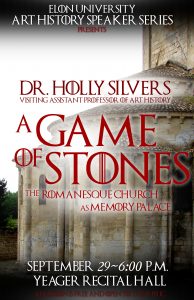 Tuesday, September 29
Tuesday, September 29
Holly Silvers, Visiting Assistant Professor of Art History
“A Game of Stones: The Romanesque Church as Memory Palace”
Yeager Recital Hall, 6:00 p.m.
In the twelfth century, the use of memory techniques spread from orators and clerics to include parishioners, who used them when passing by the village church to recall the gist of sermons or moral lessons they had heard. Sculptural and architectonic elements on the 12th-century rural French churches show distinct parallels with known textual and mnemonic practices of that period. The use of specific visual devices, shocking imagery, and patterns of order within the decorative scheme of these churches transform the structures into literal memory palaces that continue to provide visual clues to lessons and texts long since forgotten. Art History Lecture Series / Admission is free and open to the public.
Spring 2015
 Wednesday, April 22nd
Wednesday, April 22nd
Karen Overbey
Associate Professor of Art History at Tufts University
“Memory and Material: Medieval Reliquary Jewelry”
La Rose Digital Theatre (KOBC 101), 6 pm
Overbey’s talk will focus on the materiality, affect, and agency of reliquary jewelry. As containers for holy relics, personal objects such as pendants, rings, and belt buckles offered extraordinary intimacy with the divine; they also implicated the beholder in a broader Christian cosmology that depended on historical, theological, and sensory encounters with the material of reliquaries, including gold and precious gems. At the heart of this talk is a small, badly damaged rock crystal pendant reliquary, which Overbey argues created a material space where medieval Scotland and the Holy Land met through matter and imagination. This talk is part of Overbey’s current project, Material Spaces, which explores the algorithmic, diagrammatic, and spatial aspects of objects/images in medieval Britain. Overbey’s first book, Sacral Geographies (Brepols, 2012), focuses on how kings, churchmen, and other influential patrons shaped the cult of the saints at the same time they shaped the kingdoms and narratives of medieval Ireland.
Art History Speaker Series / Admission is free and open to the public.
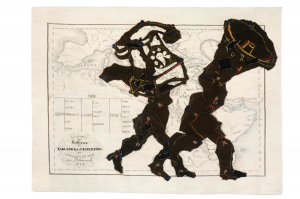
Friday, February 27
Jill H. Casid, “Art History on the Hyphen”
Keynote Speaker for Between, Among, and Across: Transhistories of the Visual
La Rose Digital Theatre (KOBC 101), 7:00 pm
The history of art is not one. Rather, taken from the vantage of what might seem deeply and canonically Western, that is, that classic of the academic painting tradition Ovid’s Metamorphoses, the history of art is already positioned on the transitive, altering, and globalizing hyphen. Through a series of propositions and case studies that move transhistorically but also globally, Casid demonstrates how re-versings of this Roman imperial text’s metamorphic scenes across a range of media work the sly and destabilizing, transformative properties of hyphenation. The ostensible foundations and origins of the Western canon of art history also shake the very ground of tradition.
The talk builds on Casid’s scholarship which has been dedicated to developing, both theoretically and historically, how imagination functions as a materializing social and political activity that shapes not just experience of a body, globe, or world but also the very matter that images might seem merely to represent. From transplantation as the engine of empire to the scene of projection as a pedagogical device that produces its subject, her research pursues the role of imaging in shaping the global.
A historian, theorist, and practicing artist, Jill H. Casid is currently Professor of Visual Studies at the University of Wisconsin-Madison where she founded and served as the first director of the Center for Visual Cultures. She received her B.A. with honors from Princeton, her M.A. from the Courtauld Institute of Art at the University of London, and her Ph.D. at Harvard. Her contributions to the transdisciplinary field of visual studies include Sowing Empire: Landscape and Colonization (Minnesota, 2006) and Scenes of Projection: Recasting the Enlightenment Subject (Minnesota, 2015) and the coedited volume Art History in the Wake of the Global Turn (Yale, 2014).
Fall 2014
 Tuesday, October 21
Tuesday, October 21
Travis Chamberlain, “’Performance Archiving Performance’ at the New Museum: Reevaluating the Museum’s Responsibility for Documenting and Archiving Performance”
Yeager Recital Hall, 6 p.m.
Travis Chamberlain is the Associate Curator of Performance at the New Museum in New York City as well as a New York Times-recognized director and producer whose recent work explores issues of legacy in contemporary performance through various forms of public engagement. In 2013, he was named one of Blouin Art Info’s “10 Cutting-Edge Curators From Around the World.” One of his recent curatorial events, “Performance Archiving Performance”, was a multi-platform presentation of projects that engage archive as medium, including work by a canary torsi, Jennifer Monson, Julie Tolentino, and Sara Wookey. Within these artists’ projects, the acts of recording, storing, indexing, and redistributing are as much a part of the work as the performance itself. As a result, the site of performance—its position in time, space, and form—is placed in question so that the actual process of archiving may be interpreted as its own mode of performance, its own singular event. Presented as part of New Museum’s 2013 Fall “Archives” Season organized by the Department of Education and Public Engagement, “Performance Archiving Performance” included an exhibition of these projects, an accompanying series of residencies, open studios, an experimental study program for teens, a workshop for families, published dialogues with the Museum’s Digital Archivist, and a lineup of performances and public talks with artists, curators, and scholars. Together these platforms provided an opportunity to reassess the role of archives and the Museum’s responsibility for their evolving forms. For this talk, Chamberlain will share a virtual walk-thru of the entire “Performance Archiving Performance” project and discuss the impact it continues to have on the Museum’s own performance document.
Art History Speaker Series
Spring 2014
 Erica Rand, “Hip Check: Queer Experiments in Looking and Writing”
Erica Rand, “Hip Check: Queer Experiments in Looking and Writing”
Tuesdsay, March 11
La Rose Digital Theater (KOBC 101)
Erica Rand’s book Red Nails, Black Skates: Gender, Cash, and Pleasure on and off the Ice (Duke, 2012) was an experiment in writing, thinking, and connection, an attempt to step away from disciplinary conventions about argumentation, articulation, and objects of study. This talk begins in a gift offered across numerous divides—rural/urban, female/femme, hips shaped and shapely—to reflect further on writing with visual culture. She focuses especially on queer and gendered dimensions of material and conceptual heft, including received notions of serious intellectual labor and, conversely, of fluff, that may harbor external or internalized sexism or anti-queerness, among various prejudices about what meaning-making and whose meaning-making matters.
Art History Speaker Series / Admission is free and open to the public.
Fall 2013
 Asa Mittman, “Are the Monstrous Races ‘Races’: Representing Difference in Medieval Art”
Asa Mittman, “Are the Monstrous Races ‘Races’: Representing Difference in Medieval Art”
Thursday, October 10
Yeager Recital Hall, 6 p.m.
Dr. Asa Mittman is Associate Professor of Art History at California State University, Chico. He is the author of Maps and Monsters in Medieval England, co-author of Inconceivable Beasts: The Wonders of the East in the Beowulf Manuscript, and A Research Companion to Monsters and the Monstrous. This talk will examine images of and text about the “monstrous races” — as well as current critical race theory — in an effort to determine if they are indeed “monstrous races,” and if we should retain or reject this characterization. The so-called “Monstrous Races” have been a popular feature of literature and art since the Ancient Greek period, when Herodotus included descriptions of cyclopses, cynocephali, and werewolves in his influential Histories. The fascinating descriptions of these wonders, believed to dwell in the distant and mythologized “East,” were repeated by Pliny the Elder in his Natural Histories, and from there, became widely distributed in the ancient and medieval worlds. In recent years, they have received great and much deserved attention from scholars, but one important element has remained almost wholly absent from such discussions. They are, again and again, referred to as “monstrous races,” and while scholars have paid close attention to their status as monsters, we have not interrogated their status as “races.” Are they races? What could this term mean for medieval audiences, and how does its use influence modern perceptions of these beings?
Art History Speaker Series / Admission is free and open to the public.
Fall 2012
 Dr. Jonathan D. Katz, “Queer Before Stonewall: Art, Eros and The Sixties”
Dr. Jonathan D. Katz, “Queer Before Stonewall: Art, Eros and The Sixties”
Tuesday, October 2
Yeager Recital Hall, 6pm
Dr. Katz is co-curator of Hide/Seek: Difference and Desire in American Portraiture, the first queer exhibition ever mounted at a major US museum. He directs the doctoral program in Visual Studies at the University at Buffalo and is presently completing a new book, The Silent Camp: Jasper Johns, Robert Rauschenberg and the Cold War, to be published by the University of Chicago Press. This lecture explores why in the art world of the late 50s and 60s, before difference was particularized, specified, embodied, and made over into artistic identity, a single, universal human capacity—Eros—was elevated to determining status and made ground for a global politic of social liberation. For a few short years, a diverse group of artists, female and male, queer and straight, as different as Richard Hamilton, Lygia Clark, Franz West, Andy Warhol, Yoko Ono and Carolee Schneemann produced an art that, in politicizing the body while obfuscating its signs of differentiation, paradoxically engendered the very specific contemporary social categories like feminist and queer that now obscure Eros’ formative and foundational role.
Art History Speaker Series / Admission is free and open to the public.
Spring 2012
 Martin Kemp, “Lost Works by Leonardo? Questions of Attribution”
Martin Kemp, “Lost Works by Leonardo? Questions of Attribution”
Arts West, Room 126
April 3rd
Martin Kemp, Emeritus Professor in the History of Art, Trinity College, Oxford and author of Leonardo and Christ to Coke: How Image Becomes Icon, will discuss intersections of art history and forensic science in the attribution of recently discovered works to Leonardo da Vinci. A light reception will follow the talk.
Art History @ Elon: A Symposium
La Rose Digital Theatre, Koury Business Center, Room101, 4:00 p.m.
February 17th

- A presentation of recent scholarship by Elon’s Art History faculty:
- Dr. Evan A. Gatti, “The Bishop’s Two Bodies & the Image In-Between”
Dr. Richard Liebhart, “Deconstructing the Architecture of the Wooden Tomb Chamber of Tumulus MM at Gordion”
Dr. Robert Mayhew, “Patterns and Preferences in the Consumption of Paintings on Paper, Cloth and Panel in Sixteenth-Century Antwerp ”
Dr. Vanessa Schulman, “New World, Old Narratives: British History in Antebellum American Painting ”
Dr. Kirstin Ringelberg will serve as moderator. - A reception will follow. This event is free and open to the public.
Fall 2011
 Sigrid Danielson , “Hands and Temperaments: Art History and the Early Medieval Artist”
Sigrid Danielson , “Hands and Temperaments: Art History and the Early Medieval Artist”
September 27
Yeager Recital Hall, 6 p.m.
Is it possible to discuss early medieval artistic identity? Danielson explores the ways scholars have worked to attribute early medieval objects with their makers and centers of production. During the first decades of the twentieth century, art historians regularly employed the themes of nationalism and authenticity to characterize those relationships. Far more than exercises in connoisseurship, these elaborate schemas often replaced the absent biography with narratives that served a variety of regional interests.
 Gwendolyn DuBois Shaw, “Righting Biography: Race, Religion, and the Internet in the Revision of American Art History”
Gwendolyn DuBois Shaw, “Righting Biography: Race, Religion, and the Internet in the Revision of American Art History”
October 24
Yeager Recital Hall, 6 p.m.
How has the internet age changed the possibilities for the writing of American art history? Can ever-increasing access to census records, maps, and books significantly change our approaches to studying works of art and the lives of the artists who made them? This talk investigates the ways that newly digitized archives and reference materials can change our understanding of artists who might otherwise have remained enigmas and works that have existed without explanation through an in-depth discussion of the Harlem Renaissance-era artist Sargent Johnson and his 1940 lithograph “Singing Saints.”